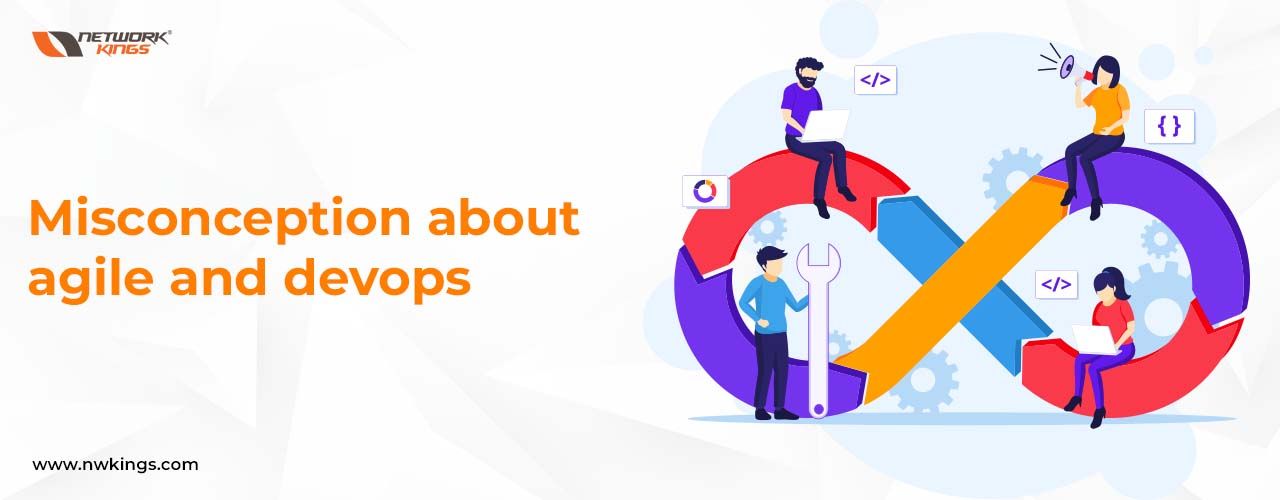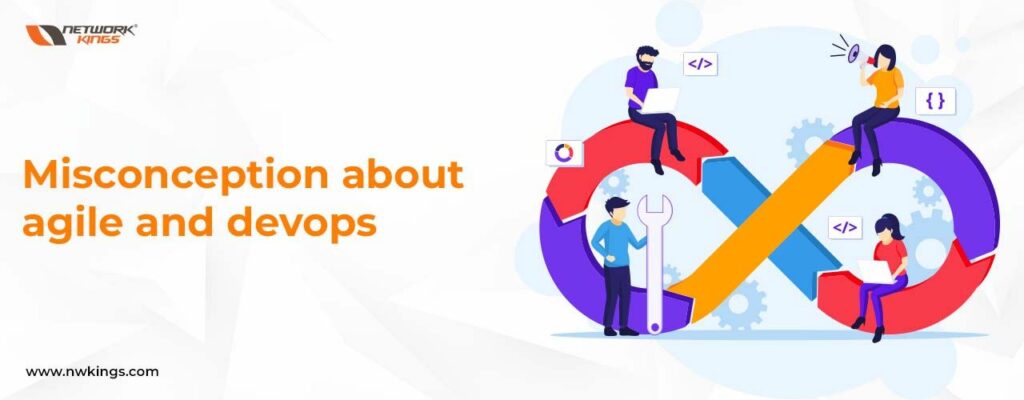
How do Agile and DevOps interrelate, let us know in detail. Agility and DevOps have become the go-to models for software development in businesses around the world. Companies are seeking to innovate swiftly and produce applications that meet customer expectations, with these two processes working together as a means of creating efficient results.
The requirement to adapt quickly while still delivering dependable outcomes is increasingly prevalent – something this blog aims to look into by looking at how Agile and DevOps interact, their advantages, practices, transformation tools and culture too! Our aim here is to provide insight into how combining both approaches can give way to amazing end products.
Understanding the Basics of Agile DevOps

Agile DevOps is a way of developing software that amalgamates the swiftness of agile method and automation through DevOps. It has become very popular recently as it helps organisations to adapt quickly according to changing market conditions, while also constructing software faster but more securely. Through Agile DevOps teams can build, test and deploy applications in a series of iterations; with these steps being data-driven decisions based on customer feedback.
Primarily speaking then, AgileDev Ops circles around collaboration between developers, operations staff and business stakeholders – which allows smooth functioning within the organisation for better development outcomes.
By working together in small cycles or iterations of development, teams can keep up with the swiftly changing market and user needs more effectively than they would by using traditional software development processes. Cross-functional team members collaborate through agile project management practices such as scrum, Kanban or extreme programming (XP).
This way their work – developers’ code and ops teams infrastructure – come together seamlessly thanks to automated configuration management tools like Ansible or Puppet. Wouldn’t it be great for any business to take advantage of this modern approach? It seems worth a try!
Agile DevOps also implements CI practices to guarantee that all code updates undergo testing against a set of automated tests before being launched into production. This guarantees any difficulty can be noticed and dealt with without detrimentally affecting end users. Moreover, Agile DevOps techniques allow corporations to swiftly deploy new features while minimising downtime by utilising rolling deployments rather than big-bang releases. This supplies end customers access to novelties in a predictable style without meddling with running services.
To conclude, Agile DevOps offers organisations a system which fuses quality assurance best practices, automation instruments and agile values into one integrated unit for constructing enterprise applications more rapidly and efficiently compared with traditional schemes do permit for; thus it is becoming unequivocally popular among organisations seeking methods of carrying on competitive in today’s continuously changing setting.
Delving into the DevOps Process

DevOps is often associated with agility, but it is more than just an agile methodology – it is a way of life. It helps organisations to develop and deliver software faster while ensuring the highest quality standards and security protocols are met. The core concept behind DevOps is that there should be continuous collaboration between development teams and operations teams; this leads to quicker testing times for changes in code as well as decreased chances of bugs entering production environments.
Ultimately, DevOps comes down to automation plus integration across all sections including development, operations and testing functions – working together seamlessly on projects!
It allows teams to put together software rapidly without compromising on quality or safety. By giving these teams a consistent workflow, they can get their product out quicker. Furthermore, by automating jobs like compile time and test spread analysis there are fewer mistakes made during the process due to human error.
Automation also helps groups oversee their infrastructure in an increasingly money-saving manner as there’s less of a chance for things going wrong when something is automated. Have you ever wondered how much costlier would be your system if it wasn’t being automated? Or what about those manual errors that could have been easily avoided with automation?
Previously, as noted, DevOps is associated with Agile methodology; both of them stress the necessity for collaboration between team members to augment efficiency and reduce any danger linked with fluctuations in the development process. Apart from this mutual venture, Agile highlights brief cycles where attributes are formulated promptly but fulfilling high-quality assurance principles at every stage. The mixture of these two methods has been confirmed fruitful for a lot of businesses that have successfully employed them amid their procedures.
To sum up, devops amalgamates progress and operations teams to work together on refining software distribution utilising automation tools which thus helps lessen discrepancies during production rollouts so customers gain better user experiences while making sure quality guarantee standards plus cost savings for companies employing devops processes effectively – what could be sounder?
Relationship between Agile and DevOps: How do Agile and DevOps Interrelate
Agile and DevOps tend to go hand in glove. Although they are two distinct approaches, both of them fulfil essential roles when it comes to helping organisations move forward rapidly while creating high-quality products. Hence, understanding the connection between these two strategies and how they could aid your business in outpacing its competitors is crucial.
Essentially speaking, Agile is all about speediness, adaptability as well and successive refinement – making sure you give the right thing at breakneck speeds being the primary focus point here! To achieve this goal efficiently – teams who follow the agile framework continuously add features over short development cycles frequently by small increments or chunks if you will!
By embracing the Agile methodology, teams can quickly react and adjust when unexpected changes occur or their customers request certain features. Taking this a step further is DevOps which automates aspects of software delivery such as testing, building images and releasing updates – achieving rapid deliveries with dependable confidence without compromising on quality or security. This assists businesses in staying competitive by not missing out due to slower release times.
So it is safe to say that both Agile and DevOps should be seen as two sides of the same coin; working together they create an effective collaborative workflow for fast feedback cycles while still maintaining great reliability across products delivered.- How can your business benefit from utilising both practices? Doing so gives you a definite edge over other companies who don’t take advantage of them!
How Agile Influences the DevOps Culture?
Agile and DevOps are two of the most important aspects of software development. Agile is an approach that concentrates on regular delivery and iterative growth, while DevOps focuses more on teamwork, automation as well and feedback loops. The relation between these two concepts can be a bit complex to comprehend but understanding it will make organisations aware of the advantages that they both hold.
Generally speaking, Agile helps with carrying out DevOps; by breaking down tasks into smaller pieces teams can produce apps quickly whilst also testing for any issues before their release onto live platforms – how effective would this be?
Automating processes becomes easier when organisations have fewer problems to tackle at the outset. Advanced testing tools such as Selenium and Appium help speed up development, allowing developers to craft tests in sync with code changes. Agile encourages collaboration between teams, which is indispensable for efficient DevOps implementations; it ensures that features are implemented properly while minimising nasty surprises during deployment time!
What’s more, having conversations about the project’s progress can keep everyone on top of what is going on and any delays can be nipped in the bud or handled quickly if they occur. Furthermore, Agile and DevOps principles encourage feedback from end users as it helps teams spot potential problems earlier and make adjustments before these have a large effect on performance or user experience.
Assessing success with metrics like the number of users or lines of code created daily gives us an idea about how efficient processes are while helping teams rank tasks according to what is most significant for their stakeholders rather than relying on nebulous guesses relating to user needs and feature requests.
To sum up: Agile plays a key part in ensuring successful DevOps implementations as it highlights speedy development cycles and encourages cross-team cooperation whilst also motivating organisations to concentrate on receiving reactions from final customers together with quantifiable metrics instead of being contented by subjective impressions or presumptions regarding projects without any factual evidence behind them.
Agile Transformation and Its Impact on DevOps
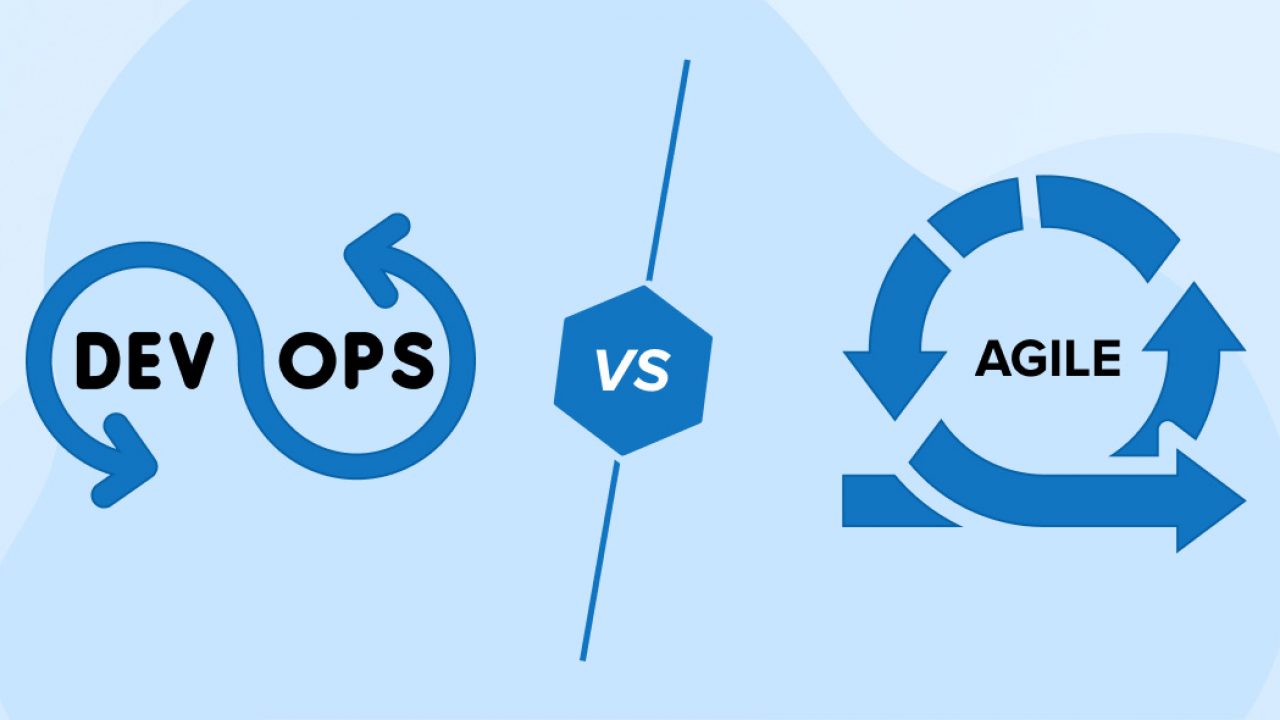
Transforming to an agile way of working can have a huge impact on DevOps. Agile transformation allows organizations to make changes quickly, as well as scale their processes more flexibly and consistently without sacrificing quality or security. It also helps make sure that development teams can continually improve upon existing systems while still maintaining effective communication among departments and stakeholders.
By embracing dynamic feedback loops between different phases within the application lifecycle, teams can ensure better product delivery times with fewer defects along the way – which is what DevOps strives for to achieve maximum performance levels from both software engineering and operational perspectives. Questions such as ‘how do we move faster?’ ‘How do we identify roadblocks so they are removed?’ become increasingly important when it comes to successful Agile Transformation initiatives linked directly to improved devops practices and outcomes – this then enables organisations to unlock previously hidden potential enabling them to swiftly react to market demands effectively combining speed with efficiency creating the ideal environment transforming ideas into reality!
As organisations carry on striving towards faster development cycles and improved quality assurance, DevOps has taken up a major part as one of the fundamental enablers for this transformation in the way we develop. At a base level, DevOps allows teams to boost speed, agility, quality control and delivery by supplying tools that connect operations personnel (“Dev”) with software engineering (“Ops”). By enabling developers to work closely alongside operational staff – such as QA testers – it makes the entire workflow simpler and more productive. What’s amazing is how well these two sides can collaborate when given the right equipment!
No doubt, DevOps helps to minimize the time-to-market of applications by getting all stakeholders involved in each development cycle. By automating test suites and deployment processes with DevOps tooling, companies can set up a consistent system that allows developers to stay nimble without having to construct testing infrastructure every single time they alter. Furthermore, this agile transformation affects how organisations transmit value through software products – what new opportunities does it open for businesses?
With the automation of tests and deployments enabled by DevOps tools allowing for shorter release cycles, product owners or business stakeholders can get feedback from users at each step in the development process. This provides them with a much better picture of user behaviour; enabling them to make informed decisions about features or changes that should be prioritised based on actual user feedback rather than assumptions made beforehand as to what users may need.
However, any organisation undergoing an agile transformation needs measures such as role clarity (who is responsible for what) and assigning ownership over functional areas like QA testing within their new workflow so there’s no muddling between roles during the implementation of updates throughout a cycle – not doing which could result in delays when releasing fresh features or introducing bug fixes resulting in customer dissatisfaction leading ultimately onto potential loss in revenue if not swiftly resolved correctly.
Exploring the Benefits of Agile DevOps
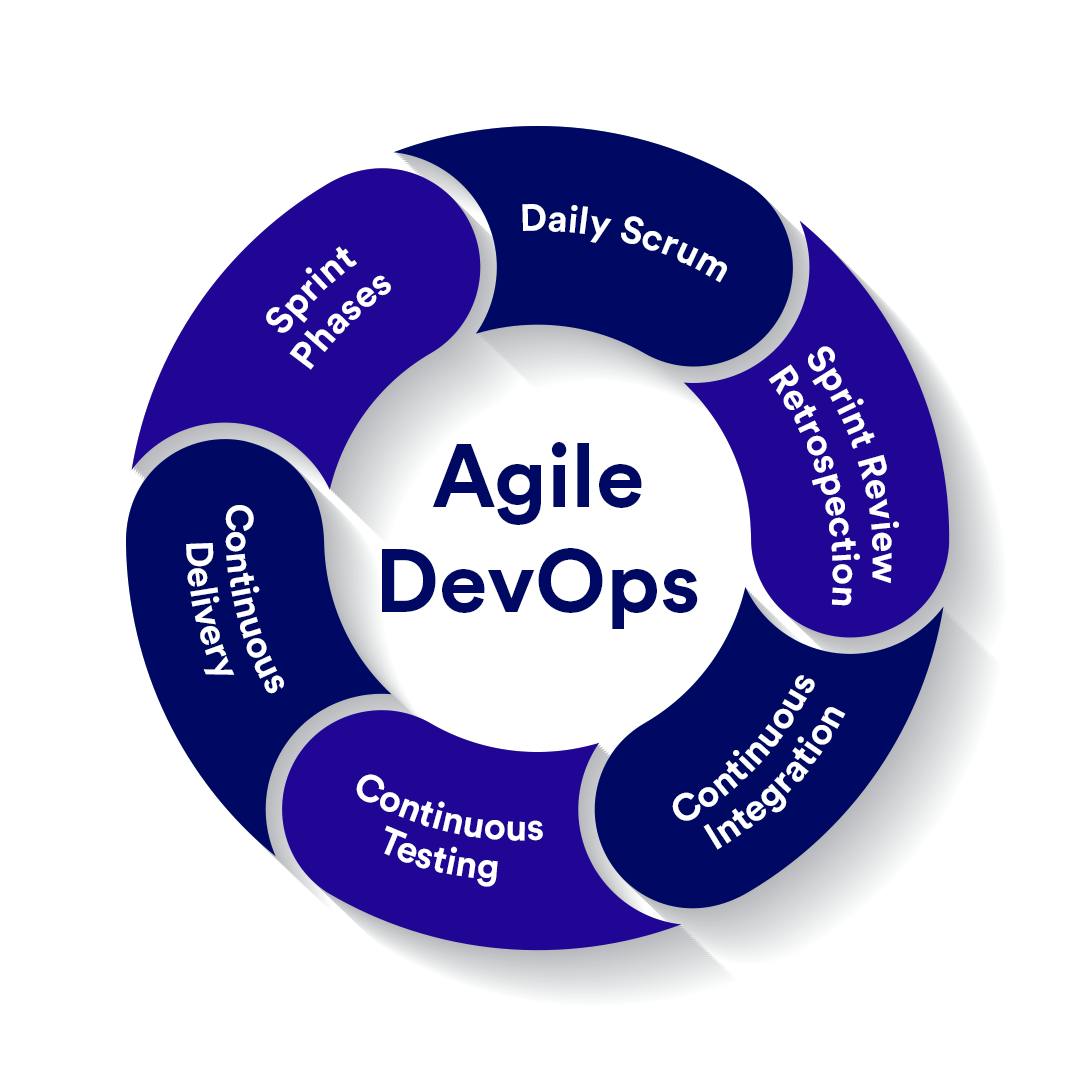
Agile and DevOps have become indispensable when it comes to modern software development. By combining both of them, organisations can create more effective workflows for developing products as well as deliver top-notch quality items quickly. If an organisation wants to maintain its place in the ever-evolving world of software engineering it must investigate the advantages that Agile DevOps present.
At the heart of Agile coding is making things simpler and easier; collaborating with others on projects; prioritising user experience throughout the production process and consistent enhancement through feedback loops which allows a team to be agile whilst also keeping up with customer demand requirements at all times – what can be better?
When it comes to getting the most out of Agile, combining it with DevOps practices can be a game changer.
Automated testing and deployments, for instance, help teams become much more efficient in their workflow. No longer do they have to manually test everything; automated testing allows them to identify bugs quickly and launch releases that are higher quality than ever before – all without taking up as much time or effort!
And so when organisations get used to living within an Agile-based environment, then there’s potential for improving even further through automation. For example: automated tests not only reduce manual labour but allow those involved in the process to spot potential issues early on – something which would otherwise take way too long by hand alone! Ultimately this means releases come out smoother with fewer problems – how good is that?!
Automating certain processes allows team members to be more productive in other areas that require more focus at the same time – think refining designs and developing new features. Agile DevOps encourages increased communication between stakeholders throughout software development, so instead of relying solely on long-term plans created before coding even begins you can adjust according to feedback from users or changes in technology trends quickly. Structured ways of communicating within different departments help prevent silos from forming within an organisation which then leads to improved collaboration across teams altogether.
Exploring the advantages offered by Agile DevOps gives organisations a chance to take full advantage of modern software development while creating high-quality products meeting customer needs effectively too! If both approaches are used correctly, companies can prepare for any current or future challenges related to producing softwares without falling behind their competitors either – it is worth looking into if there are potential gains out there waiting for your company!
The Role of Agile in a DevOps Environment

Agile and DevOps are two of the most popular software engineering frameworks of this decade, both designed to enhance efficiency, dependability and quality in software development. Knowing how these two methodologies interact is key if you want to get all the benefits from them. In a DevOps environment with Agile involved, briefening up the process for constructing new applications tends to be prioritised.
The iterative procedure which characterises Agile emphasises small upgrades made over time as opposed to one massive alteration at once. Agile allows small teams or even individuals to relentlessly progress on their tasks while simultaneously ensuring that any little mistakes don’t slip the net and can be remedied quickly.
Furthermore, Agile also promotes a cross-functional team with varied skill sets so they are more able to answer customer’s changing demands without delay. Regarding the DevOps environment, Agile gives us an understanding of what should come next by examining client opinions and ordering jobs in order of importance. How would it feel if we had an idea about the potential problems our customers might face before they do?
By taking an incremental approach, Agile can turn complex tasks into simpler parts that you can get finished quicker – and spot any potential issues in advance. Plus when you make use of automation processes such as continuous integration it helps teams cut down on manual procedures like testing and deployment cycles which nets a faster delivery all around.
What’s more is, that Agile is very flexible so it gels well with DevOps techs like containers or Kubernetes clusters – meaning developers don’t need to start from scratch if they are switching between different infrastructures for the same project. All in all, integrating Agile into your DevOps set-up gives value; not just getting products out quickly but also keeping up quality during development thanks to its thorough testing practices. Have you thought about combining these two philosophies?
How DevOps Complements the Agile Method?
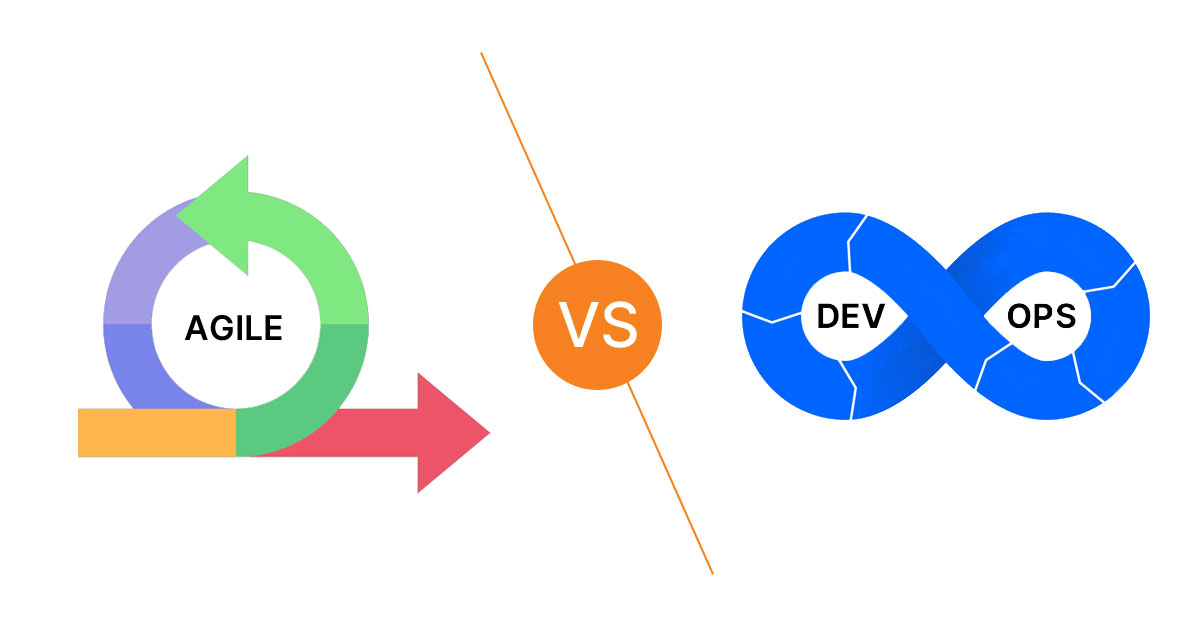
DevOps is a way of doing software development that helps a team to develop, test and deploy their code quicker and more efficiently. DevOps aims to blend bits from agile processes, continuous delivery as well and other operational procedures – which makes the entire software dev process better. DevOps enhances Agile by making it simpler for frequent coding updates while keeping up quality standards, streamlining communication between teams and enhancing automation capabilities. It encourages collaboration between developers and IT operations crews with the aim in mind of reducing the amount of time spent getting changes live.
Agile gives teams a structure to create and deliver working software quickly with fewer faults than traditional techniques while ensuring customer satisfaction. This increases flexibility, responsiveness, speed-to-market as well and cost-effectiveness of development projects. On the other hand, DevOps introduces an automated process that allows developers to concentrate on delivering steady code quickly without disturbing existing systems or introducing technical debt. Additionally, it also helps eradicate manual mistakes when managing complex applications or environments.
The blend of Agile and DevOps can produce great gains in productivity for organisations that make use of it properly. Teams can rapidly implement alterations without impacting present systems; this guarantees stability in production while granting groups the freedom to experiment confidently. By combining Agile’s step-by-step procedure with DevOps’ programmed processes, associations can get better quality products out faster without negotiating quality or dependability.
They can reduce risk by deploying regularly tested software updates automatically into productive atmospheres within shorter cycles which additionally provide visibility into every stage of the application growth lifecycle including testing and deployment stages – something that wasn’t conceivable before taking on these two approaches together.
The Synergy between Agile Transformation and DevOps

The idea of Agile Transformation and DevOps is tightly linked. Both come from the philosophies of non-stop development, speedy delivery, automation, customer-focused design and cross-team work. So what exactly does Agile Transformation mean? It is all about creating an agile attitude within a company by applying agile standards to the whole business – forming teams that work together effectively as well as testing out new tools and processes for more effective operations.
On the flip side, DevOps is an approach that unites computer software dev teams and information technology operations personnel using automation technologies like continuous integration, constant delivery as well and containerisation. The relationship between Agile Transformation and DevOps can be noticed in several primary facets. To give one example, both terms accentuate automatization to reduce manual labour and create fast outcomes.
Also making use of automated instruments helps speed up the development process by quickly assimilating modifications into production systems or releasing them faster for customers’ consumption. This all goes towards improving efficiency while reducing cost at the same time – sounds too good to be true?
Agile Transformation and DevOps work together to help organisations thrive. Through embracing agile processes, businesses can rapidly adapt their strategies according to customer feedback – this helps them stay ahead of the competition while also making sure they deliver high-quality products quickly. With DevOps, companies can automate various tasks such as build tests or deployment scripts for greater efficiency and speed in production environments.
So not only do these two methodologies combine forces when it comes to improving product quality – but they also promote better collaboration between departments by fostering an environment where all teams strive towards a common goal! Ultimately, both Agile Transitions and DevOps have a huge amount of value which is why so many firms now embrace them; helping ensure success long into the future!
When it comes to delivering digital products quickly with quality, this collaborative environment combined with DevOps practices like Continuous Integration and Deployment (CI/CD) pipelines makes integration between different departments much more seamless – allowing for projects to be completed in a fraction of the time traditional methods require.
It is no surprise that organizations need both these disciplines working together if they are going to remain competitive in this ever-shifting landscape. A great example of how Agile Transformation and DevOps go hand-in-hand can be seen when companies implement them side by side; improving their understanding and cooperation amongst teams which leads to faster delivery times as well as reducing waste.
Ways to Successfully Integrate Agile and DevOps
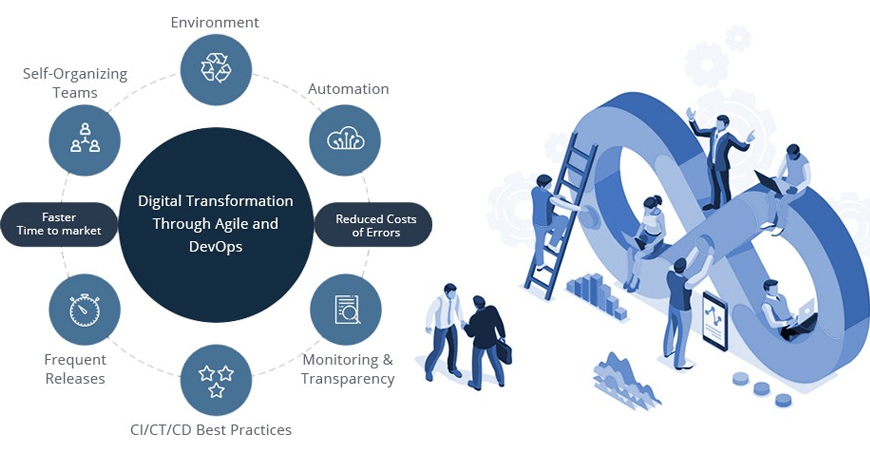
It is critical to get a handle on how Agile and DevOps fit together for successful integration. Essentially, Agile is all about building software incrementally whereas DevOps focuses on automating the delivery process. This means that both methodologies can be used to their mutual advantage to enhance quality levels while also speeding up deliveries. Take a team working with an agile system, they could integrate devops systems which would enable them to automate release cycles providing more surety plus faster timescales getting products onto shelves quicker!
At first sight, it may seem that there are a lot of clashes between Agile and DevOps. But when taking a closer look – lots of aspects have in common! If you want to succeed with the combination of those two approaches, all teams must break down barriers between operation and development departments within the organization so they can collaborate towards achieving one goal. Additionally, everyone needs to be ready for quick changes in their environment as needed without compromising quality or introducing too much risk into the process.
Effective communication between stakeholders throughout the product lifecycle is another critical factor for the successful integration of Agile and DevOps. All those involved should have an appreciation of each methodology’s purpose, so they can work together rather than independently with limited understanding about one another’s progress or objectives.
In addition, teams require resources such as task boards, chat rooms and online surveys to enable communications over multiple departments in support of collaboration among spread-out squads.
Eventually, prosperous blending involves ploughing capital into staff training so everyone comprehends how their duty fits within a bigger framework encompassing both Agile and DevOps practices. Without appropriate instruction, crews are liable to misunderstanding how particular jobs fit inside a wider picture causing misalignment amongst development endeavours or latency due to vagueness regarding procedures.
Therefore, when musing on how Agile and DevOps intertwine organisations need to identify that investing in coaching is imperative for guaranteeing these two approaches cooperate effectively instead of producing differences inside their institution.
Wrapping Up!
In conclusion, Agile and DevOps have both been game-changers in the way software development processes are managed. By utilizing these two approaches together you can benefit from increased speed, agility and scalability as well as improved reliability when delivering complex systems. Agile’s lightweight framework enables rapid project planning while DevOps delivers a comprehensive approach to automation alongside culture change that aids with the quick delivery of top-quality results. When combined organizations could reach ambitious heights in their software development endeavours – how amazing would it be if they did?
Fancy getting into DevOps? Kick-start your career with our comprehensive DevOps Master’s Program! Our course is taught by real industry experts who are passionate about helping you succeed. You’ll gain practical skills and knowledge in Systems Administration, Cloud Computing, Infrastructure Automation and more – plus the ability to engineer your solutions for fast deployment of applications across large networks. Take control of where your career goes today; sign up now!
Happy Learning!

